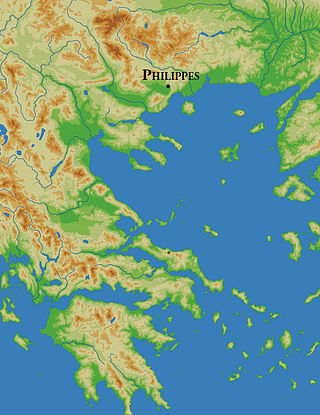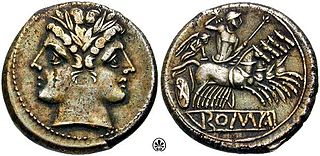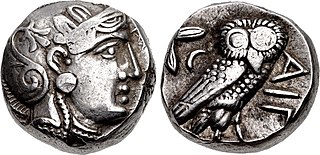
A coin is a small object, usually round and flat, used primarily as a medium of exchange or legal tender. They are standardized in weight, and produced in large quantities at a mint in order to facilitate trade. They are most often issued by a government. Coins often have images, numerals, or text on them. The faces of coins or medals are sometimes called the obverse and the reverse, referring to the front and back sides, respectively. The obverse of a coin is commonly called heads, because it often depicts the head of a prominent person, and the reverse is known as tails.

The denarius was the standard Roman silver coin from its introduction in the Second Punic War c. 211 BC to the reign of Gordian III, when it was gradually replaced by the antoninianus. It continued to be minted in very small quantities, likely for ceremonial purposes, until and through the Tetrarchy (293–313).

The Battle of Philippi was the final battle in the Liberators' civil war between the forces of Mark Antony and Octavian and the leaders of Julius Caesar's assassination, Brutus and Cassius, in 42 BC, at Philippi in Macedonia. The Second Triumvirate declared the civil war ostensibly to avenge Julius Caesar's assassination in 44 BC, but the underlying cause was a long-brewing conflict between the so-called Optimates and the so-called Populares.

Roman currency for most of Roman history consisted of gold, silver, bronze, orichalcum and copper coinage. From its introduction during the Republic, in the third century BC, through Imperial times, Roman currency saw many changes in form, denomination, and composition. A persistent feature was the inflationary debasement and replacement of coins over the centuries. Notable examples of this followed the reforms of Diocletian. This trend continued with Byzantine currency.

The quadrigatus was a medium-sized silver coin produced by the Roman Republic during the 3rd century BC. The obverse featured a young janiform bust and the reverse featured Victory driving a quadriga, giving the coin its Roman name, with the inscription "ROMA" below.
Roman Republican currency is the coinage struck by the various magistrates of the Roman Republic, to be used as legal tender. In modern times, the abbreviation RRC, "Roman Republican Coinage" originally the name of a reference work on the topic by Michael H. Crawford, has come to be used as an identifying tag for coins assigned a number in that work, such as RRC 367.

The Coinage of India began anywhere between early 1st millennium BCE to the 6th century BCE, and consisted mainly of copper and silver coins in its initial stage. The coins of this period were Karshapanas or Pana. A variety of earliest Indian coins, however, unlike those circulated in West Asia, were stamped bars of metal, suggesting that the innovation of stamped currency was added to a pre-existing form of token currency which had already been present in the Janapadas and Mahajanapada kingdoms of the Early historic India. The kingdoms that minted their own coins included Gandhara, Kuntala, Kuru, Magadha, Panchala, Shakya, Surasena, Surashtra and Vidarbha etc.

Phraates IV was King of Kings of the Parthian Empire from 37 to 2 BC. He was the son and successor of Orodes II, and was given the throne after the death of his brother Pacorus I. Phraates IV soon murdered all his brothers, and also possibly his father. His actions alienated the Armenians and also some of his nobles, including the distinguished Monaeses, who fled to the Roman triumvir Mark Antony, but shortly returned and reconciled with Phraates IV.
Lucius Pinarius Scarpus was a Roman who lived during the late Republic and the early Empire. He served as the Roman governor of Cyrene, Libya during the War of Actium. He was originally loyal to Mark Antony, but eventually switched sides and joined Octavian following the latter's victory at the Battle of Actium in 31 BC.

The War of Actium was the last civil war of the Roman Republic, fought between Mark Antony and Octavian. In 32 BC, Octavian convinced the Roman Senate to declare war on the Egyptian queen Cleopatra. Her lover and ally Mark Antony, who was Octavian's rival, gave his support for her cause. Forty percent of the Roman Senate, together with both consuls, left Rome to join the war on Antony's side. After a decisive victory for Octavian at the Battle of Actium, Cleopatra and Antony withdrew to Alexandria, where Octavian besieged the city until both Antony and Cleopatra were forced to commit suicide.

Legio VI Ferrata was a legion of the Imperial Roman army. In 30 BC it became part of the emperor Augustus's standing army. It continued in existence into the 4th century. A Legio VI fought in the Roman Republican civil wars of the 40s and 30s BC. Sent to garrison the province of Judaea, it remained there for the next two centuries.

The Achaemenid Empire issued coins from 520 BC–450 BC to 330 BC. The Persian daric was the first gold coin which, along with a similar silver coin, the siglos represented the first bimetallic monetary standard. It seems that before the Persians issued their own coinage, a continuation of Lydian coinage under Persian rule is likely. Achaemenid coinage includes the official imperial issues, as well as coins issued by the Achaemenid provincial governors (satraps), such as those stationed in Asia Minor.
Gaius Sosius was a Roman general and politician who featured in the wars of the late Republic as a staunch supporter of Mark Antony. Under the latter's patronage he held important state offices and military commands, serving as governor of Syria and leading the expedition to install Herod as king of Judea. Sosius was consul in the year 32 BC, when the Second Triumvirate lapsed and open conflict erupted between the triumvirs Antony and Octavian. Upon taking office, Sosius opposed Octavian in the Senate, for which he was forced to flee Rome.

The Liberators' civil war was started by the Second Triumvirate to avenge Julius Caesar's assassination. The war was fought by the forces of Mark Antony and Octavian against the forces of Caesar's assassins, led by Marcus Junius Brutus and Gaius Cassius Longinus, referred to as the Liberatores. The latter were defeated by the Triumvirs at the Battle of Philippi in October 42 BC, and committed suicide. Brutus committed suicide after the second part of the battle.

The triumvir monetalis was a moneyer during the Roman Republic and the Empire, who oversaw the minting of coins. In that role, he would be responsible for the "ordinary coinage" during the republican period. Roman moneyers almost always acted together as a board of three, hence their title triumvir.
Carthaginian or Punic currency refers to the coins of ancient Carthage, a Phoenician city-state located near present-day Tunis, Tunisia. Between the late fifth century BC and its destruction in 146 BC, Carthage produced a wide range of coinage in gold, electrum, silver, billon, and bronze. The base denomination was the shekel, probably pronounced in Punic. Only a minority of Carthaginian coinage was produced or used in North Africa. Instead, the majority derive from Carthage's holdings in Sardinia and western Sicily.
The Pompeian–Parthian invasion of 40 BC occurred after the Pompeians, backed by the Parthian Empire, had been defeated during the Liberators' civil war by Mark Antony and Octavian.

The Kabul hoard, also called the Chaman Hazouri, Chaman Hazouri or Tchamani-i Hazouri hoard, is a coin hoard discovered in the vicinity of Kabul, Afghanistan in 1933. The collection contained numerous Achaemenid coins as well as many Greek coins from the 5th and 4th centuries BCE. Approximately one thousand coins were counted in the hoard. The deposit of the hoard is dated to approximately 380 BCE, as this is the probable date of the least ancient datable coin found in the hoard.
The Fleet coinage was a set of bronze coins minted by Mark Antony in the eastern Mediterranean from 40 BC until 30 BC. The coinage introduced Roman-style denominations to the eastern half of the Roman empire and formed the basis for the monetary reforms under Augustus. The coinage is also referred to by numismatists as RPC 1 1453-70 and 4092, after their designation in M. H. Crawford, Roman Republican Coinage (1975).

















